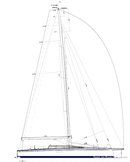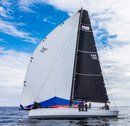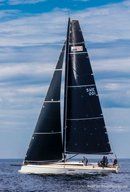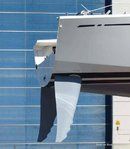Club Swan 50
Sailboat specifications
The Club Swan 50 is a 50’ (15.24m) one design sailboat designed by Juan Yacht Design (Spain). She is built since 2016 by Nautor's Swan (Finland). She has been awarded "2018 - Sailing World - Boat of the Year: Best One-Design", "2018 - SAIL magazine - Best Performance Boat over 40ft" and "2018 - European Yacht of the Year: Performance Cruiser".
Find out more about the Club Swan 50 on Boat-Spec's blog: European Yacht of the Year 2018.
Find out more about the Club Swan 50 on Boat-Spec's blog: European Yacht of the Year 2018.
Club Swan 50's main features
- Model
- Club Swan 50
- Hull type
- Monohull
- Category
- One design sailboat
- Sailboat builder
- Sailboat designer
- Sailboat range
- Country
- Finland
- Construction
- Carbon fiber reinforced epoxy:
Sandwich PVC carbon fiber epoxy - First built hull
- 2016
- Last built hull
- Still in production
- Award(s)
- 2018: Sailing World - Boat of the Year: Best One-Design
- 2018: SAIL magazine - Best Performance Boat over 40ft
- 2018: European Yacht of the Year: Performance Cruiser
- Appendages
- Keel : fin with bulb
- Helm
- Twin helm wheels
- Rudder
- Twin spade rudders
- Unsinkable
- No
- Trailerable
- No
- EC design categoryiThe CE design category indicates the ability to cope with certain weather conditions (the sailboat is designed for these conditions)
A: Wind < force 9, Waves < 10m
B: Wind < force 8, Waves < 8m
C: Wind < force 6, Waves < 4m
D: Wind < force 4, Waves < 0,5m - A
- Standard public price ex. VAT (indicative only)
- About1 100 000 €(2020)
Club Swan 50's main dimensions
- Overall length
- 54’ 11”16.74 m
- Hull length
- 50’15.24 m
- Waterline length
- 45’ 11”14 m
- Beam (width)
- 13’ 10”4.2 m
- Draft
- 11’ 6”3.5 m
- Light displacement (MLC)
- 18739 lb8500 kg
- Ballast weight
- 7496 lb3400 kg
- Ballast type
- Carbon fiber fin with lead bulb
Club Swan 50's rig and sails
- Upwind sail area
- 1701 ft²158 m²
- Downwind sail area
- 3907 ft²363 m²
- Mainsail area
- 1001 ft²93 m²
- Genoa area
- 700 ft²65 m²
- Asymmetric spinnaker area
- 2906 ft²270 m²
- IiFore triangle height (from mast foot to fore stay top attachment)
- 65’ 4”19.9 m
- JiFore triangle base (from mast foot to bottom of forestay)
- 20’ 5”6.22 m
- PiMainsail hoist measurement (from tack to head)
- 65’ 8”20.04 m
- EiMainsail foot measurement (from tack to clew)
- 24’ 5”7.43 m
- Rigging type
- Sloop Marconi 9/10
- Mast configuration
- Deck stepped mast
- Rotating spars
- No
- Number of levels of spreaders
- 3
- Spreaders angle
- Swept-back
- Spars construction
- Carbon fiber spars
Club Swan 50's performances
- Upwind sail area to displacementiThe ratio sail area to displacement is obtained by dividing the sail area by the boat's displaced volume to the power two-thirds.
The ratio sail area to displacement can be used to compare the relative sail plan of different sailboats no matter what their size.
Upwind: under 18 the ratio indicates a cruise oriented sailboat with limited performances especially in light wind, while over 25 it indicates a fast sailboat. - 408 ft²/T37.94 m²/T
- Downwind sail area to displacementiThe ratio sail area to displacement is obtained by dividing the sail area by the boat's displaced volume to the power two-thirds.
The ratio sail area to displacement can be used to compare the relative sail plan of different sailboats no matter what their size. - 938 ft²/T87.16 m²/T
- Displacement-length ratio (DLR)iThe Displacement Length Ratio (DLR) is a figure that points out the boat's weight compared to its waterline length. The DLR is obtained by dividing the boat's displacement in tons by the cube of one one-hundredth of the waterline length (in feet).
The DLR can be used to compare the relative mass of different sailboats no matter what their length:
a DLR less than 180 is indicative of a really light sailboat (race boat made for planning), while a DLR greater than 300 is indicative of a heavy cruising sailboat. - 88
- Ballast ratioiThe Ballast ratio is an indicator of stability; it is obtained by dividing the boat's displacement by the mass of the ballast. Since the stability depends also of the hull shapes and the position of the center of gravity, only the boats with similar ballast arrangements and hull shapes should be compared.
The higher the ballast ratio is, the greater is the stability. - 40 %
- Critical hull speediAs a ship moves in the water, it creates standing waves that oppose its movement. This effect increases dramatically the resistance when the boat reaches a speed-length ratio (speed-length ratio is the ratio between the speed in knots and the square root of the waterline length in feet) of about 1.2 (corresponding to a Froude Number of 0.35) . This very sharp rise in resistance, between speed-length ratio of 1.2 to 1.5, is insurmountable for heavy sailboats and so becomes an apparent barrier. This leads to the concept of "hull speed".
The hull speed is obtained by multiplying the square root of the waterline length (in feet) by 1.34. - 9.08 knots
Club Swan 50's auxiliary engine
- Engine(s)
- 1 inboard engine
- Engine(s) power
- 75 HP
- Fuel type
- Diesel
- Fuel tank capacity
- 79.3 gal300 liters
Club Swan 50's accommodations and layout
- Cockpit
- Closed aft cockpit
- Cabin(s) (min./max.)
- 2 / 3
- Berth(s) (min./max.)
- 4 / 8
- Head(s)
- 1
- Freshwater tank capacity
- 92.5 gal350 liters
- Holding tank capacity
- 21.1 gal80 liters


Nautor's Swan Club Swan 50 - - 1/14
Picture extracted from the commercial documentation © Nautor's Swan
Picture extracted from the commercial documentation © Nautor's Swan


Nautor's Swan Club Swan 50 sailplan - - 2/14
Picture extracted from the commercial documentation © Nautor's Swan
Picture extracted from the commercial documentation © Nautor's Swan


Nautor's Swan Club Swan 50 layout - - 3/14
Picture extracted from the commercial documentation © Nautor's Swan
Picture extracted from the commercial documentation © Nautor's Swan


Nautor's Swan Club Swan 50 layout - - 4/14
Picture extracted from the commercial documentation © Nautor's Swan
Picture extracted from the commercial documentation © Nautor's Swan


Nautor's Swan Club Swan 50 sailing - - 5/14
Picture extracted from the commercial documentation © Nautor's Swan
Picture extracted from the commercial documentation © Nautor's Swan


Nautor's Swan Club Swan 50 sailing - - 6/14
Picture extracted from the commercial documentation © Nautor's Swan
Picture extracted from the commercial documentation © Nautor's Swan


Nautor's Swan Club Swan 50 sailing - - 7/14
Picture extracted from the commercial documentation © Nautor's Swan
Picture extracted from the commercial documentation © Nautor's Swan


Nautor's Swan Club Swan 50 sailing - - 8/14
Picture extracted from the commercial documentation © Nautor's Swan
Picture extracted from the commercial documentation © Nautor's Swan


Nautor's Swan Club Swan 50 sailing - - 9/14
Picture extracted from the commercial documentation © Nautor's Swan
Picture extracted from the commercial documentation © Nautor's Swan


Nautor's Swan Club Swan 50 interior and accommodations - - 10/14
Picture extracted from the commercial documentation © Nautor's Swan
Picture extracted from the commercial documentation © Nautor's Swan


Nautor's Swan Club Swan 50 interior and accommodations - - 11/14
Picture extracted from the commercial documentation © Nautor's Swan
Picture extracted from the commercial documentation © Nautor's Swan


Nautor's Swan Club Swan 50 interior and accommodations - - 12/14
Picture extracted from the commercial documentation © Nautor's Swan
Picture extracted from the commercial documentation © Nautor's Swan


Nautor's Swan Club Swan 50 interior and accommodations - - 13/14
Picture extracted from the commercial documentation © Nautor's Swan
Picture extracted from the commercial documentation © Nautor's Swan


Nautor's Swan Club Swan 50 detail - - 14/14
Picture extracted from the commercial documentation © Nautor's Swan
Picture extracted from the commercial documentation © Nautor's Swan
Similar sailboats that may interest you:
Sailboats
First built hull
Hull length
1988
52’ 6”16 m
2012
49’ 2”14.99 m
2016
45’ 4”13.8 m
2007
40’12.18 m
2016
39’ 4”11.99 m
2017
40’12.2 m
2015
45’ 1”13.75 m
2006
42’ 7”12.98 m
2001
45’ 5”13.83 m
2006
42’ 7”12.98 m
2000
52’ 6”16 m
2017
50’ 11”15.51 m
2018
55’ 1”16.8 m
2019
51’ 10”15.8 m
2016
46’ 2”14.09 m